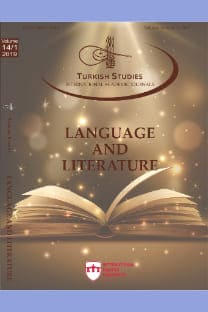An Ecofeminist Reading of Charlotte Perkins Gilman’s “The Yellow Wallpaper” (1892)
Charlotte Perkins Gilman’ın “Sarı Duvar Kâğıdı” (1892) Adlı Eserinin Ekofeminist Bir Okuması
___
Akalın T. & Baş, R. (2018). Toplumsal cinsiyet eşitsizliğinin kadın sanatçılara yansıması. Marmara University Journal of Women and Gender Studies, 2(2), 112-128. https://dergipark.org.tr/tr/download/article-file/615064Bo, T. (2018). An ecofeminist interpretation of Sons and Lovers. Theory and Practice in Language Studies, 8(11), 1499-1503. http://dx.doi.org/10.17507/tpls.0811.15
Boslaugh, S. E. (2016). “Anthropocentrism”. Encyclopedia Britannica. https://www.britannica.com/topic/anthropocentrism.
Buell, L. (2005). The future of environmental criticism: environmental crisis and literary imagination. Blackwell Publishing.
Cova, A. (2012). Feminism. 559-563. https://repositorio.ul.pt/bitstream/10451/23703/1/ICS_ACova_Feminism_EDI.pdf
Çetin, O. (2005). Ekofeminizm: Kadın doğa ilişkisi ve ataerkillik. Sosyoekonomi, 1(1), 61-76. https://dergipark.org.tr/tr/pub/sosyoekonomi/issue/21061/226778
Gilman, C. P. (1892). “The Yellow Wallpaper”. https://www.nlm.nih.gov/exhibition/theliteratureofprescription/exhibitionAssets/digitalDoc s/The-Yellow-Wall-Paper.pdf
Glotfelty, C. & Fromm, H. (1996). The ecocriticism reader. The University of Georgia Press.
Güngör, T. Ö. & Erkan, M. (2020). Ekoeleştirel bakışla Robinson Cruose, Zor Zamanlar ve Su Diyarı eserlerinin incelenmesi. Kriter Yayınevi.
Güngör, T. Ö. (2020a). Maggie Tulliver as a new woman in George Eliot’s The Mill on the Floss, Kafkas University Journal of the Institute of Social Sciences, Spring (25), 71-80. doi.org/10.9775/kausbed.2020.005
Güngör, T. Ö. (2020b). Vengeance of nonhuman beings: An ecocritical reading of Samuel Taylor Coleridge’s work, “The Rime of The Ancient Mariner”, International Journal of Social, Political and Economic Research, 7(2), 359-371. doi.org/10.46291/IJOSPERvol7iss2pp359- 371
Kolay, H. (2015). Kadın harketlerinin süreçleri, hedefleri ve kazanımları. EMO Kadın Bülteni, (3), 5-11. https://www.emo.org.tr/ekler/1bb5fa7cf6b4360_ek.pdf?dergi=990
LeGuin, U. K. (1989). “Women/Wilderness.” (Ed. Judith Plant), Healing the Wounds: The Promise of Ecofeminism. New Society.
Merchant, C. (1993). The death of nature: women, ecology and scientific revolution. Harper & Row.
Notaro, A. (1999). Space and domesticity in The Yellow Wallpaper by Charlotte Perkins Gilman. Journal of American Studies of Turkey. 10(1999), 59-68. https://dergipark.org.tr/tr/download/article-file/996000
Özyön, A. (2020). A journey of feminist rebellion through Charlotte Perkins Gilman’s short story The Yellow Wallpaper and her novel Herland. International Journal of Language Academy. 8(5), 115-124. http://dx.doi.org/10.29228/ijla.47013
Plumwood, V. (1993). Feminism and the mastery of nature. Routledge.
Rady, K. S. A. (2018). Ecofeminism and the deconstruction of dualisms: Theorising contemporary American women's writing [Unpublished PhD Dissertation]. Durham University.
Roach, C. (1996). “Loving your mother: On the woman-nature relation.” In Ecological Feminist Philosophies. Indiana UP. 52–65.
Şentürk, S. (2020). Kinship reimagined: family in Doris Lessing’s fiction. Peter Lang.
Tan, C. (2020a). An ecofeminist interpretation of J.G. Ballard’s The Drowned World. Turkish Academic Research Review, 6 (1), 12-26. https://doi.org/10.30622/tarr.849939
Tan, C. (2020b). An ecofeminist reading of Joseph Conrad’s Heart of Darkness and Chinua Achebe’s Things Fall Apart. International Journal of Language Academy, 8(5), 344-351. http://acikerisim.pau.edu.tr:8080/xmlui/bitstream/handle/11499/35373/IJLA-CenkTan.pdf?sequence=1&isAllowed=y
Tasneem A. (2020). Ecofeminism: Exploitation of women and nature. International Journal of English Literature and Social Sciences, 5(4), 846-848. https://dx.doi.org/10.22161/ijels.54.2
Taş, G. (2016). Feminizm üzerine genel bir değerlendirme: Kavramsal analizi, tarihsel süreçleri ve dönüşümleri. The Academic Elegance, 3(5), 163-175. https://dergipark.org.tr/tr/download/article-file/269956
Wright, M. (2018). “Feminism.” Keywords for African American Studies. NYU Press. 86-89. http://www.jstor.org/stable/j.ctvwrm5v9.21
Zhang, X. (2020). Ecofeminism in Thea Astley’s Drylands. Advances in Language and Literary Studies. 11(3), 42-45. http://dx.doi.org/10.7575/aiac.alls.v.11n.3p.42
- ISSN: 2667-5641
- Yayın Aralığı: 4
- Başlangıç: 2006
- Yayıncı: ASOS Eğitim Bilişim Danışmanlık Otomasyon Yayıncılık Reklam Sanayi ve Ticaret LTD ŞTİ
Adnan Özyalçıner’in Öykülerinde Geriye Dönüş Tekniği
Reşat Nuri Güntekin’in Hülleci Adlı Tiyatro Eserinde Komiğin Anlamı Üzerine: Bergsoncu Bir Bakış
Memleket Gazetesi Işığında Reşat Nuri Güntekin
Tırpan’daki Toplumcu Gerçekçi Temel İlkeler Üzerine
Reşat Nuri Güntekin’in Kitaplarına Girmemiş Üç Hikâyesi
Reşat Nuri Güntekin'in Yeşil Gece Adlı Romanında Kavram Alanı Üzerine Bir Deneme
Kânûnî Dönemi Kânûnnâmelerine Bir Örnek: Âsafnâme
Distopik Bir Romanın Kurgusu ve Çözülümü: Kazuo Ishiguro’nun Never Let Me Go Romanı
Revelation and Unfolding of a Dystopian Novel: Never Let Me Go by Kazuo Ishiguro*
